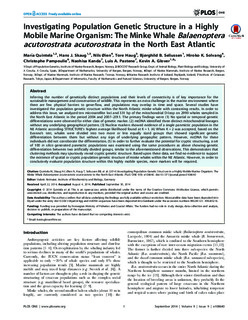| dc.contributor.author | Quintela, Maria | |
| dc.contributor.author | Skaug, Hans Julius | |
| dc.contributor.author | Øien, Nils | |
| dc.contributor.author | Haug, Tore | |
| dc.contributor.author | Seliussen, Bjørghild B. | |
| dc.contributor.author | Solvang, Hiroko Kato | |
| dc.contributor.author | Pampoulie, Christophe | |
| dc.contributor.author | Kanda, Naohisa | |
| dc.contributor.author | Pastene, Luis A. | |
| dc.contributor.author | Glover, Kevin A. | |
| dc.date.accessioned | 2014-10-29T15:08:10Z | |
| dc.date.available | 2014-10-29T15:08:10Z | |
| dc.date.issued | 2014-09-30 | |
| dc.identifier.citation | Quintela M, Skaug HJ, Øien N, Haug T, Seliussen BB, et al. (2014) Investigating Population Genetic Structure in a Highly Mobile Marine Organism: The Minke Whale Balaenoptera acutorostrata acutorostrata in the North East Atlantic. PLoS ONE 9(9): e108640. doi:10.1371/journal.pone.0108640 | nb_NO |
| dc.identifier.issn | 1932-6203 | |
| dc.identifier.uri | http://hdl.handle.net/11250/225009 | |
| dc.description.abstract | Inferring the number of genetically distinct populations and their levels of connectivity is of key importance for the sustainable management and conservation of wildlife. This represents an extra challenge in the marine environment where there are few physical barriers to gene-flow, and populations may overlap in time and space. Several studies have investigated the population genetic structure within the North Atlantic minke whale with contrasting results. In order to address this issue, we analyzed ten microsatellite loci and 331 bp of the mitochondrial D-loop on 2990 whales sampled in the North East Atlantic in the period 2004 and 2007–2011. The primary findings were: (1) No spatial or temporal genetic differentiations were observed for either class of genetic marker. (2) mtDNA identified three distinct mitochondrial lineages without any underlying geographical pattern. (3) Nuclear markers showed evidence of a single panmictic population in the NE Atlantic according STRUCTURE's highest average likelihood found at K = 1. (4) When K = 2 was accepted, based on the Evanno's test, whales were divided into two more or less equally sized groups that showed significant genetic differentiation between them but without any sign of underlying geographic pattern. However, mtDNA for these individuals did not corroborate the differentiation. (5) In order to further evaluate the potential for cryptic structuring, a set of 100 in silico generated panmictic populations was examined using the same procedures as above showing genetic differentiation between two artificially divided groups, similar to the aforementioned observations. This demonstrates that clustering methods may spuriously reveal cryptic genetic structure. Based upon these data, we find no evidence to support the existence of spatial or cryptic population genetic structure of minke whales within the NE Atlantic. However, in order to conclusively evaluate population structure within this highly mobile species, more markers will be required. | nb_NO |
| dc.language.iso | eng | nb_NO |
| dc.publisher | Public Library of Science | nb_NO |
| dc.rights | Navngivelse 3.0 Norge | * |
| dc.rights.uri | http://creativecommons.org/licenses/by/3.0/no/ | * |
| dc.title | Investigating Population Genetic Structure in a Highly Mobile Marine Organism: The Minke Whale Balaenoptera acutorostrata acutorostrata in the North East Atlantic | nb_NO |
| dc.type | Journal article | nb_NO |
| dc.type | Peer reviewed | nb_NO |
| dc.subject.nsi | VDP::Agriculture and fishery disciplines: 900::Fisheries science: 920::Resource biology: 921 | nb_NO |
| dc.source.pagenumber | 15 p. | nb_NO |
| dc.source.volume | 9 | nb_NO |
| dc.source.journal | PLoS ONE | nb_NO |
| dc.source.issue | 9 | nb_NO |
| dc.identifier.doi | 10.1371/journal.pone.0108640 | |

